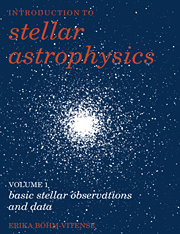Book contents
- Frontmatter
- Contents
- Preface
- 1 Positions of stars
- 2 Proper motions of stars
- 3 Distances of nearby stars
- 4 The brightnesses of the stars
- 5 Color magnitude diagrams
- 6 The luminosities of the stars
- 7 Angular radii of stars
- 8 Effective temperatures of stars
- 9 Masses and radii of stars
- 10 Spectral classification
- 11 Understanding stellar spectra
- 12 Population II stars
- 13 Stellar rotation
- 14 Stellar magnetic fields
- 15 Stars with peculiar spectra
- 16 Pulsating stars
- 17 Explosive stars
- 18 Our sun
- 19 Interstellar absorption
- Appendixes
- References
- Index
1 - Positions of stars
Published online by Cambridge University Press: 04 August 2010
- Frontmatter
- Contents
- Preface
- 1 Positions of stars
- 2 Proper motions of stars
- 3 Distances of nearby stars
- 4 The brightnesses of the stars
- 5 Color magnitude diagrams
- 6 The luminosities of the stars
- 7 Angular radii of stars
- 8 Effective temperatures of stars
- 9 Masses and radii of stars
- 10 Spectral classification
- 11 Understanding stellar spectra
- 12 Population II stars
- 13 Stellar rotation
- 14 Stellar magnetic fields
- 15 Stars with peculiar spectra
- 16 Pulsating stars
- 17 Explosive stars
- 18 Our sun
- 19 Interstellar absorption
- Appendixes
- References
- Index
Summary
The coordinate system
If we want to study stars, the first thing to look at might be their positions in the sky. This in itself does not tell us much about the nature of the stars, but it is very helpful when we want to find a particular star or a group of stars in the sky. We have to have a reference point with respect to which we can describe the position of the star in which we are interested. We all know or have at least heard about the constellations of stars which in earlier times were extremely helpful in describing the positions of stars with respect to a given star in a particular constellation. We still name the brightest stars according to the constellations in which they are found, but we like to have a more general description of the positions. When looking at the sky we can measure the positions only as projected against the sphere of the sky, i.e., against a two-dimensional surface. We can therefore describe the positions of the stars by two quantities. Since the surface against which we measure the positions is a sphere, we use spherical polar coordinates. Since our telescopes are fixed on the Earth, we use a coordinate system which is fixed with respect to the Earth. The Earth is rotating, but we do not want to have a rotating coordinate system, which would cause many problems.
Information
- Type
- Chapter
- Information
- Introduction to Stellar Astrophysics , pp. 1 - 6Publisher: Cambridge University PressPrint publication year: 1989
